The Philodendron Birkin is a unique and popular houseplant. It is a rare and beautiful plant with striking white and light yellow stripes on its green heart shaped leaves. It is easy to grow, perfect for beginners who want an ideal display plant.
Want some knowledge on how to take care of this plant? Let’s learn more below.
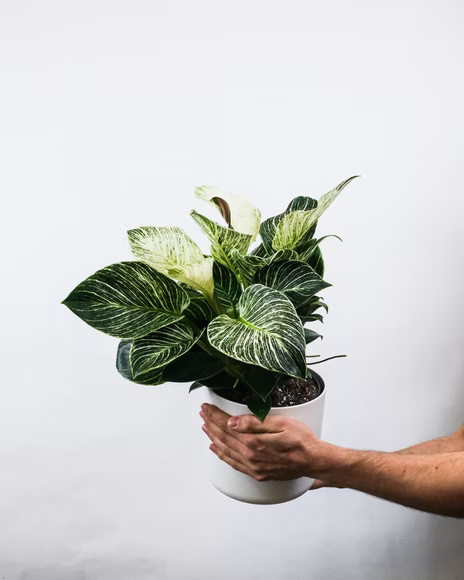
Philodendron Birkin Profile
General Information
Plants known as Philodendrons were initially discovered in Brazil in the 17th century. Philodendrons come in about 450 varieties, some of which have become popular houseplants.
The Philodendron Birkin is becoming increasingly popular. Its lush green leaves recognize philodendron Birkin with white or yellow pinstripes, which were once uncommon.
Unfortunately, these plants do not grow naturally in the wild since they were created due to a rare, spontaneous gene mutation in the Rojo Congo Philodendron. The mutation was replicated in all plants’ cells giving rise to the beautiful and uncommon Philodendron Birkin.
Etymology
The name “philodendron” comes from the Greek words “philo”, meaning “love” and “affection”, and “dendron,” meaning tree. So the philodendron is loosely translated as “tree huggers” with these meanings. This is because they are often seen in the wild as tree climbers.
The cultivar name “Birkin” refers to the designer bags of a well-known elite brand as this plant was once referred to as a “designer plant”. This is due to its extravagant varieties.
Flowering
A Philodendron is a flowering plant that belongs to the Araceae family. Like any other aroids, they produce an inflorescence called a spadix. However, the flowers are insignificant as compared to their gorgeous foliage.
Season of Interest and Purchasing
Philodendron Birkins are widely available all over the world. They are one of the sought-after Philodendrons, hence the massive cultivation of these species. Therefore, it is best to purchase them during the summer and spring seasons.
Growth
During the growing season, Philodendron Birkin grows quickly, but it slows down during the rest of the year. When planted in-ground or flowerpot soil, Philodendron Birkin is content to grow to its full size as long as the requirements for healthy growth are met. Philodendron Birkin is a fast-growing plant.
Philodendron “Birkin” Overview
| Scientific name | Philodendron “Birkin” |
| Common name/s | Birkin, Philodendron Birkin |
| Family | Araceae |
| Growth Habit | Herbaceous |
| Height and Spread | Climbs up to 8-12 feet or more, leaf spreading |
| Classification based on life cycle | Perennial |
| Origin and Distribution | Native in Tropical America, widely distributed in South and Central America |
| Climate Zone | Generally warmer climate |
| USDA Plant Hardiness Zone | USDA Zone 9 – 12 |
| Color | Dark evergreen leaves with yellow and cream pinstriped variegations; unstable variegation |
Care Tips
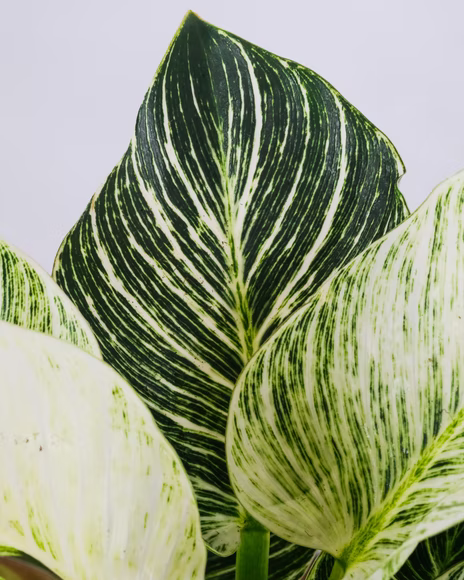
Light Requirement
Philodendron Birkin plant requires only a certain quantity of sunlight throughout the day. It thrives best in bright indirect light. It does not like dim light, but it does not want to be in direct sunlight. This makes it ideal for windowsills that set it in an east or west-facing window or just about anywhere else in a bright area away from windows.
Unfortunately, overexposure to direct sunlight can cause leaves to fall off. On the other hand, low light. On the other hand, low light will not give you beautiful variegated plants. Artificial lights can be used indoors to make your plant receives enough light. Ensure you meet the Philodendron Birkin light requirements so your plant grows healthy.
Temperature Requirement
A Philodendron Birkin plant thrives at a room temperature range of 65°F to 75°F (18°C to 24°C) during the day. Therefore, a warm, humid environment is ideal for the Birkin. However, because these are tropical plants, keep in mind that the temperature should never fall below 65 degrees Fahrenheit (18C). This can result in yellowing and/or falling leaves.
Water Requirement
Your Philodendron ‘Birkin’ will enjoy its soil being maintained at least somewhat damp during the summer months while it is actively growing. Once the top of the soil is dry, water your Philodendron Birkin. However, you should avoid overwatering your plant to avoid the dreaded wet foot.
Let the soil dry thoroughly before watering the Birkin plant in the winter. If you’re looking for a watering schedule for this plant, generally, it should be watered once a week.
Humidity Requirement
Philodendron Birkin is a tropical plant that thrives in humid conditions. This is one of the reasons it prefers to spend much of its time in moist soil. Therefore, maintain a humidity level of 60% or above for Philodendron Birkin.
Although they can survive in low humidity, the plant will be healthier if the environment is moist. For example, a Philodendron Birkin can become brown because of a lack of moisture. Put a damp cloth near the plant to add moisture.
Soil Requirement
The soil must be well-drained and airy, however, not too loose. This soil condition keeps the Birkin plant hydrated but not soaked. The finest mix for Philodendron Birkin is peat, perlite, charcoal, coco coir, orchid bark, and some potting soil. This mix retains moisture, keeping your moist soil, and loose enough to drain excess water to prevent root rot.
Philodendron Birkin’s maintenance requires plenty of nutrients. Simply make sure the potting mix is high-quality.
RELATED: Yellow? Goodbye! 7 Reasons Why Your Philodendron Is Changing Color
Fertilizer Requirement
Philodendron Birkin should be fertilized to keep the plant healthy and maintain the beauty of its leaves. Balanced liquid fertilizer is the preferred fertilizer for the plant. In addition, the fertilizer should contain essential nutrients such as magnesium and calcium, which are necessary for the plant’s nutrition.
Fertilize Philodendron Birkin once a month in the spring and summer during the growing season. In the autumn and winter, fertilize every other month. Avoid fertilizing it too much or too often, as this may cause irregular growth and nutrition in the plant. You can add worm castings for additional nutrients.
Space Requirement
Philodendron Birkin is an excellent indoor plant. Because it is a relatively mid-sized plant, it only needs minimal space to thrive. Therefore, it is perfect to put in your space corners and on tabletops.
RELATED: Philodendron verrucosum: The Number 1 Care, Propagation, and Watering Guide for This Velvety Plant
Growing And Planting Tips
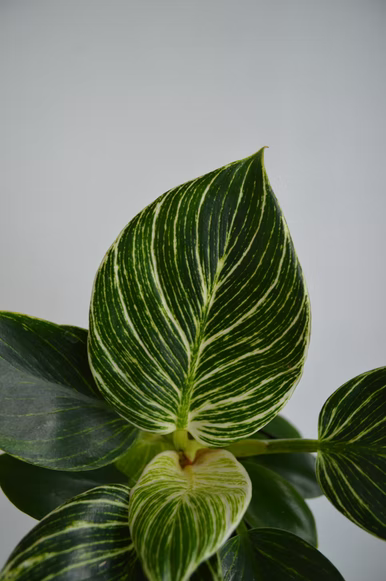
Propagation
To propagate the Birkin, cut a stem from your Philodendron Birkin that contains a node. Put the stem cuttings in water, soil, or sphagnum moss to facilitate rooting.
The complete steps on how to propagate Philodendron Birkin using stem cuttings is below:
- Find at least one healthy leaf on a stalk on your parent plant.
- Cut the stem below a node with clean, sharp scissors or a knife. Your cut must have a node because nodes are the source of new development.
- Make sure to place your cutting in a moist potting mix under a medium to indirect light
- Do not put your cuttings under direct sunlight
- Maintain a high level of humidity as the roots develop and new growth emerges
Philodendron Birkin propagation is best done during its actively growing seasons, spring and summer. The same with other plants in the Philodendron family.
Pruning
Pruning your Philodendron Birkin isn’t necessary. Pruning should be done in the spring or fall, and pruning shears should be used to provide a clean cut. You can also give your Philodendron Birkin a small trim throughout the year, removing any fading leaves or areas infested by pests or disease.
If a mature Philodendron Birkin reverts to its non-variegated condition, pruning may be required to maintain the plant’s appearance as lively and healthy as possible.
Potting And Repotting
First, see if your Philodendron Birkin needs re-potting. Outgrowths of roots on the drainage holes are a great sign to re-pot. It’s time to transfer your roots to a larger pot when you see that they’ve spread as far as they can at the bottom of your existing one. Then, gently place the philodendron in the new pot to avoid destroying the roots.
It takes a year for Birkin plants to develop after re-potting. Others will take two years on average. If you’re re-potting your Birkini Philodendron, use a 1-2 inches bigger pot than the old one to allow plenty of areas to grow.
Philodendron “Birkin” Care
| Light | Medium to indirect bright light |
| Temperature | Intermediate to warm, 65-75 degrees Fahrenheit |
| Water | Once a week, increased in summer, decreased in winter |
| Soil | Airy, well-draining soil; not too loose |
| Fertilization | Regular household fertilizer, once a month |
| Space | Minimal space |
| Propagation | Via stem cutting propagation |
| Blooming | Rarely blooms, enough sunlight and maturity needed |
| Pruning | Regular pruning |
| Potting | Regular potting mix, use of peat, charcoal, perlite and orchid bark is recommended |
Problems And Troubleshooting
Overwatering
Overwatered philodendrons develop yellow and wet leaves. These eventually fall over. Double-check your soil before you decide to water it again. Check to see if it’s entirely dry. Make sure your pot has drainage holes to avoid overwatering your plant.
To save the plant, follow these simple procedures.
- Before adding extra water, allow the soil to dry.
- Check for water drainage holes in the pot.
- Place the plant directly in the sun to avoid too much moisture and water og.
- Replant it in a different container if it isn’t working and make sure to use a well-draining soil
Underwatering
The soil will dry out completely if you don’t give your Philodendron Birkin enough water. This means the plant won’t be able to grow properly because it won’t have enough resources. You must hydrate your Philodendron Birkin if it is dying due to being underwatered. Gently water your Philodendron Birkin to put your plant back to proper health.
Brown leaf tips and brown leaves that are crispy are signs of underwatered plant. Ensure you follow the appropriate Philodendron Birkin watering frequency.
Nutrient Deficiency
When nutrients are lacking, your Philodendron Birkin leaves turn yellow and wilt. Some symptoms include stunted root growth and leaf formations. To remedy this, fertilize your plant using high-quality fertilizers and ensure proper fertilizing schedules depending on the season.
Flowering Problems
Philodendron Birkin has an unpredictable blooming season. Therefore, philodendron Birkin plants are unlikely to flower indoors. As a result, knowing when these plants will bloom is impossible. However, to ensure that your Birkin blooms, provide it with the finest possible care and attention.
Philodendron “Birkin” Pests And Diseases
| Common Pests/Diseases | Symptoms | Treatment and Prevention |
Common diseases include crown rot, stem rot, root rot, leaf spot, fungal diseases, and Xanthomonas infection | Yellowish rimming around black or dark brown spots on leaves | Avoid overwatering. Keep soil dry. Avoid too high humidity.Proper ventilation is needed around the plant. Remove infected parts of fungal infections to avoid spreading |
| Common pests include mealybugs, spider mites, aphids, and scales | Visible insects on the surface | Spray plant with warm, soapy water. If infestation is present, use insecticide or neem oil. Use diatomaceous earth. |
Problem With People And Animals
Toxicity
The toxic compounds of Philodendron Birkin are found in the leaves and stems. These plant parts contain calcium oxalate crystals that are harmful to both pets and people. Make sure it’s out of the reach of your pets and small children to avoid dangerous consequences.
Philodendron Birkin Meaning and Symbolism
Philodendron is a Greek word that means “tree lover.” With these, they symbolize love and affection for nature. They are great gifts to people who are nature lovers and advocate eco-friendly living.
Philodendron plants also symbolize personal growth.
Philodendron “Birkin” Symbolism And Meaning
| General Meaning | love of nature, passion for eco-friendly living |
| Symbolism | Personal growth |
Landscaping and Gardening Ideas
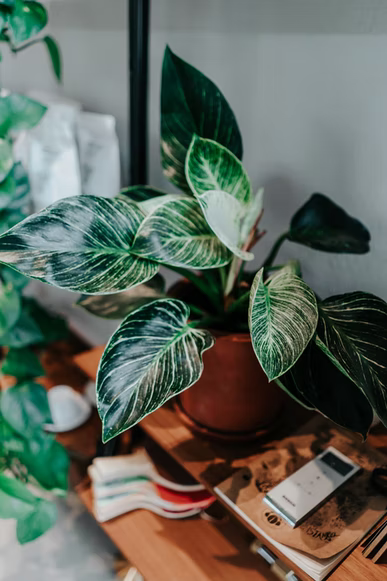
Companion Plants
Philodendrons go well with other tropical plants. Consider using bird of paradise, areca palms, fire spike, heliconia, variegated arboricola, croton, chenille plant, and pentas to plant along with Birkin. The colors of these plants, mainly warm oranges and reds, will complement the foliage color of Birkin perfectly.
Landscaping Ideas
Medium-sized Philodendrons go well as accents inside a humid room or a cozy deck or patio. An entire plant can also be placed in the corner of the house or along the entryway. Outdoors, it can be a filler plant for a garden corner, in between palm trunks, or under tall trees. It can also be placed near pools to add even more tropical vibes as long as it won’t get splashed at.
| What to plant with | Bird of Paradise, Areca Palms, Fire Spike, Heliconia, Variegated Arboricola, Croton, Chenille Plant, Pentas |
| What NOT to plant with | Basically nothing |
Conclusion
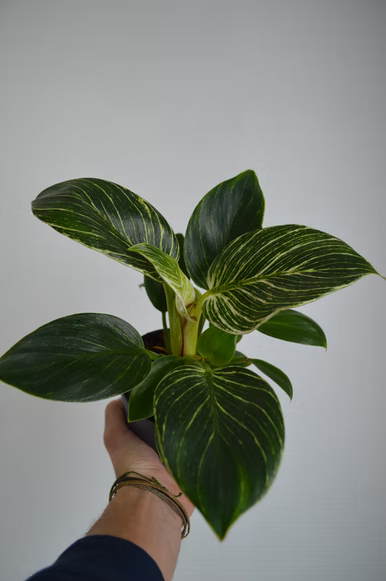
The Philodendron Birkin is a well-known plant. It’s a lovely and simple plant to grow. The rich green leaves of the Philodendron Birkin have white or yellow pinstripes. These plants are rare and variegated and are only produced as “designer plants.” As a smaller philodendron, this plant is ideal for adding a tropical touch to your home.
Frequently Asked Questions
Can a Philodendron Birkin revert?
Yes, your Philodendron Birkin can revert as it has unstable variegations. When it does, prune the reverted leaves. Do the pruning continuously until variegations can be seen again on the newly grown foliage.
Also, ensure proper light conditions are met. Dark green foliage will dominate in low light, without an efficient light source. Avoid direct sunlight at all times.
Is Philodendron Birkin slow growing?
Birkins are relatively fast-growing plants. They can grow faster outdoors than indoors. To facilitate their growth, ensure proper pot size is used. Also, ensure adequate nourishment and attention is given to your plant.
Is Philodendron Birkin toxic?
Like most Aroids, the leaves and stems of Philodendrons contain calcium oxalate crystals which are toxic to both pets and humans. They can cause throat irritation and swelling. In the worst cases, they can even cause death. So make sure it is out of reach of your pets and children.
Is Birkin an indoor plant?
Definitely yes! Birkin is a well-known indoor plant that can thrive in a suitable room condition, provided that proper lighting and humidity are ensured. In addition, they are good tabletop displays because of the variegations in their leaves.
How big does a Philodendron Birkin grow?
A Philodendron Birkin has a height of 10-12 inches and a spread of 12-14 inches. It is a mid-size plant and does not require an ample space to grow.
Hope you like our Philodendron Birkin article. Make sure to check out our other articles:
Philodendron Warscewiczii: The #1 Complete Care, Watering, and Propagation Guide
Philodendron Splendid: The Fail-Proof Care, Propagation, and Watering Guide You Need
Philodendron Spiritus Sancti: The Best and Complete Care, Watering, and Propagation Guide







